
Magnolia kobus
Encyclopedia

Magnolia
Magnolia is a large genus of about 210 flowering plant species in the subfamily Magnolioideae of the family Magnoliaceae. It is named after French botanist Pierre Magnol....
native to Japan
Japan
Japan is an island nation in East Asia. Located in the Pacific Ocean, it lies to the east of the Sea of Japan, China, North Korea, South Korea and Russia, stretching from the Sea of Okhotsk in the north to the East China Sea and Taiwan in the south...
and occasionally cultivated in temperate areas. It is a deciduous
Deciduous
Deciduous means "falling off at maturity" or "tending to fall off", and is typically used in reference to trees or shrubs that lose their leaves seasonally, and to the shedding of other plant structures such as petals after flowering or fruit when ripe...
, small to tall tree which has a slow rate of growth but can reach 8-15 m (25-75 ft) in height and up to 10 m (35 ft) in spread.
Classification
Two varieties of Magnolia kobus are recognized by some sources, such as Hortus Third, with var. borealis being a tree to 25m (75 ft) high, with leaves to 15 cm (6 in) long, and var. kobus, a tree to 10 m (30 ft) high,with leaves to 10 cm (4 in) long.M. kobus is classified within Magnolia subgenus
Subgenus
In biology, a subgenus is a taxonomic rank directly below genus.In zoology, a subgeneric name can be used independently or included in a species name, in parentheses, placed between the generic name and the specific epithet: e.g. the Tiger Cowry of the Indo-Pacific, Cypraea tigris Linnaeus, which...
Yulania.
The Kobushi magnolia is closely related to the star magnolia (Magnolia stellata), and some authorities consider the star magnolia to be a variety of M. kobus, M. kobus var. stellata.
Description
Magnolia kobus blooms in the early spring, bearing pleasantly fragrant white flowers with hints of pale pink about 10 cm (4 in) in diameter. The flowers are produced before the leaves, as with most members of Magnolia subgenus Yulania. Young trees do not flower.The summer foliage of the Kobushi magnolia is dark green. Leaves have an obovate
Leaf shape
In botany, leaf shape is characterised with the following terms :* Acicular : Slender and pointed, needle-like* Acuminate : Tapering to a long point...
shape with a pointed tip, a smooth, or glabrous, leaf underside, and smooth, even edges. Leaves are 8-15 cm (3-6 in) long, in an alternating
Alternating
Alternating may refer to:In mathematics:*alternating form*alternating group*alternating series*alternating knot*alternating mapIn electronics:*alternating current...
arrangement. In autumn, the leaves take on a yellow color and drop from the tree.
The fruit of the Kobushi magnolia grows in groups of small red seeds. The groupings are one to three inches in size, and the seeds attract birds.
Older bark, such as that of the trunk, is grey-brown, while new stems are green with small brown spots. There is a strong odor to broken branches or twigs.
Culture
The Kobushi magnolia prefers full sun to partialPartial
Partial may refer to:*partial derivative, in mathematics** ∂, the partial derivative symbol, often read as "partial"*partial function, in mathematics*partial algorithm, in computer science*part score, in contract bridge...
shade, rich, well-drained soil, and is tolerant of acidic soils. It can be propagated
Plant propagation
Plant propagation is the process of creating new plants from a variety of sources: seeds, cuttings, bulbs and other plant parts. Plant propagation can also refer to the artificial or natural dispersal of plants.-Sexual propagation :...
either by seed or by cuttings.

